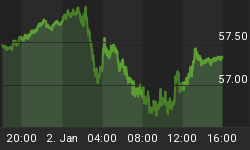In today's FX charts strategy, we select the Aussie as the currency with the most upside potential across the board as risk appetite returns to the market, and this evening's Australian inflation figures are expected to lift the currency. Rallying Asian equities are boosting European trade after China's CITIC and US' Bear Stearns announced the would buy a portion in one another's shares.
Declining oil prices, resulting from a weak US outlook and Turkey 's attempts to bring a diplomatic solution to its tensions with Kurdish guerillas, is also boosting market confidence. The lack of US data may be another green light for additional buying on the dips in US equities barring any negative earnings announcements and dire warnings of a US recession.
Sentiment, momentum indicate looming gold top
Gold prices are recovering past the $757 per ounce level after a brief $8 pullback in Monday's trade to $749. An extended return to risk appetite is likely to sustain gold's rally, but we do warn of the incipient signals from all time highs in the weekly net longs among speculative futures and a bearish divergence in the weekly gold stochastics. The fundamental catalyst of the next gold retreat is likely to emerge from: 1) a global equity selloff that would extend unwinding of carry trades and dollar advances; 2) a Chinese rate hike that woud be perceived as a downside risk for Chinese commodity appetite; 3) upside surprise in this week's US housing figures or a figure less weak than expected. We have also warned that gold prices are highly overstretched in relative terms, where the daily deviation must not exceed more than 110%-112% of its 200-day moving average.

Playing the Aussie's rebound ahead of CPI
The charts below show not only the negative technicals for gold in Aussie terms (a sign of anticipated broadening improvement for the currency) but also of the upside potential for AUDUSD. Already gaining ground in European trade, Aussie is likely to be bid ahead of this evening's Q3 CPI (9.30 pm EST) expected to raise the odds for an RBA rate hike as early as next month. CPI is expected to have risen 0.9% q/q from 1.2%, but this week's stronger than expected showing of Q3 PPI of 1.1% in Q3 versus expectations of 0.8%, is likely to trigger a CPI figure of at least 1.1%. It is worth noting that Australia 's PPI report has had a successful rate in predicting the magnitude of CPI over the past 4 quarterly releases.
We expect AUDUSD to chart a climb towards 89.50, at which point we could see a retreat until the release of the CPI report. A strong report is seen calling up the 89.80 figure, followed by 90.20. Support stands at 89.00, backed by 88.70.
We continue to favor AUDEUR (63.10) and AUDGBP (44.00).

When does the euro pullback and when does it not?
Euro's sharp pullback in Monday's US trade were a combination of re-emerging downside risks in the Eurozone that may hamper the ECB's hawkish policy and unwinding of dollar shorts especially as gold prices had begun a rare a retreat. The reason the euro had not been dragged by last Friday's equity sell-off was due to the US - specific nature of the catalysts of the selloff i.e. earnings losses from the US top banks (Citigroup, BoA and Wachovia), dismal US housing starts/building permits and higher probabilities of a US recession by US cargo/transportation firms. Once the US Friday sell-off was followed by sharp losses in Asian and European shares on Monday, risk aversion trades became more global and so was the unwinding in the dollar shorts. Thus it is not only important to discern the activity in US and non US equities, but also to be aware of the catalysts to these losses.
Separately, Eurozone new industrial orders rose 0.3% in August from July, and were up 5.1% on a year-on-year basis, versus forecasts of 0.9% m/m and 6.0% y/y.
The euro's losses risk intensifying in the event of an accelerating gold sell-off below the $730 per ounce mark, which would risk breaching $1.40. Such a gold selloff would either take place in the unlikely event of surprisingly strong US data or more likely intensifying losses in global equities. The euro's medium term outlook remains largely bullish as foreign central banks and Sovereign wealth funds buying euros on the dips as part of their FX reserves balancing act.
EURUSD eyes resistance at $1.4210 followed by 1.4240. Key resistance stands at 1.4290m which is just above the 61.8% retracement of the 1.4352-1.4124 decline. Support stands at 1.4175, followed by 1.4150.
USDJPY allows temporary upside
USDJPY is off its 113.22 low but we expect renewed losses near the open of the US equity session is expected to target the 113 figure, 50% retracement of the rally from the January 21 low to the 1214.12 high. Since USDJPY is widely used gauge of risk appetite, the potential for an inter-meeting Fed cut prior to the Oct 31 announcement, or a 50-bp rate cut at the scheduled meeting, may surprise to the upside and trigger a dosage of risk appetite, weighing on the Japanese yen. Nonetheless, further easing would mean further erosion in the dollar's yield foundation, thus, relegating it to the league of low yielding currencies. This will not only limit the upside move in USDJPY but also accelerate the anticipated rebound in gold. Upside capped at 114.40, followed by 114.70.

















